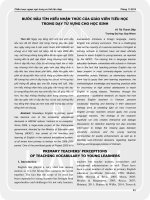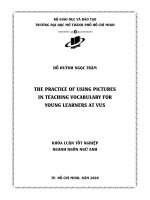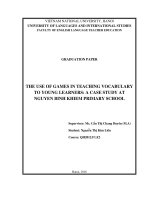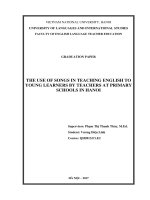Efl teachers’ perceptions of teaching vocabulary to young learners at quy nhon based primary schools
Bạn đang xem bản rút gọn của tài liệu. Xem và tải ngay bản đầy đủ của tài liệu tại đây (671.93 KB, 78 trang )
MINISTRY OF EDUCATION AND TRAINING
QUY NHON UNIVERSITY
LE THI THANH THI
EFL TEACHERS’ PERCEPTIONS OF TEACHING
VOCABULARY TO YOUNG LEARNERS AT QUY
NHON-BASED PRIMARY SCHOOLS
Field: Theory and Methodology of English Language Teaching
Code: 8140111
Supervisor: Dr. Truong Van Dinh
Binh Dinh - 2023
BỘ GIÁO DỤC VÀ ĐÀO TẠO
TRƯỜNG ĐẠI HỌC QUY NHƠN
LÊ THỊ THANH THI
NHẬN THỨC CỦA GIÁO VIÊN ANH NGỮ VỀ VIỆC DẠY
TỪ VỰNG CHO HỌC SINH NHỎ TUỔI TẠI CÁC
TRƯỜNG TIỂU HỌC Ở QUY NHƠN
Ngành: Lý luận và phương pháp dạy học bộ môn Tiếng Anh
Mã số: 8140111
Người hướng dẫn: TS. Trương Văn Định
i
STATEMENT OF AUTHORSHIP
The thesis entitled “EFL Teachers’ Perceptions of Teaching Vocabulary
to Young Learners at Quy Nhon-based Primary Schools” is conducted
under the direction of Dr. Truong Van Dinh at Quy Nhon University.
I declare that the information reported in this study results from my work
and effort, except where due reference is made. This thesis has not been
submitted to any university for the award of a degree.
Binh Dinh, 2023
Le Thi Thanh Thi
ii
ACKNOWLEDGEMENTS
First, I would like to express my gratitude to the EFL teachers at primary
school who participated in this study. Without their participation, this study
would not have been accomplished.
I am enormously grateful to my supervisor, Dr. Truong Van Dinh, for his
excellent guidance, support, patience, and invaluable assistance. He has always
been available to support me not only academically but also spiritually.
I would also like to thank the lecturers in English, Department of
Pedagogy, Quy Nhon University, for their support and guidance throughout the
research process.
Besides, I am also indebted to the cooperation and support of 15 EFL
teachers who spent their valuable time participating in the survey for my data
collection.
Last but not least, my family members have been enormously supportive
of my efforts to complete this project. I am grateful to my parents for always
encouraging and guiding me in my pursuits. They are the epitome of good role
models.
Le Thi Thanh Thi
iii
ABSTRACT
Nowadays, early English education has become one of the increasing
demands in the world. The purpose of this research is to find out about
primary school EFL teachers’ perceptions of teaching English vocabulary to
young learners at primary level. This research was phenomenology research
which was conducted in 4 Quy Nhon-based primary schools. To answer the
research questions, the researcher employed both quantitative and qualitative
approaches. The qualitative approach was used with a questionnaire
distributed to 15 primary teachers at 04 Quy Nhon-based primary schools
and the qualitative approach was employed with interviews with these
primary teachers to explore their perceptions and challenges of teaching
English vocabulary to young learners. The results showed that the primary
school EFL teachers had positive perceptions of the importance of teaching
English vocabulary to young learners. Most primary school EFL teachers
agreed that teaching vocabulary, selecting vocabulary and employing
techniques are of great importance because of its usefulness in enhancing
young learners’ ability to learn vocabulary. The results also revealed many
essential aspects of vocabulary instruction, ranging from selecting
vocabulary and challenges for primary school EFL teachers. This study is
expected to give reference and knowledge to primary school EFL teachers
so that they can implement some suitable strategies for their own classes.
Keywords: vocabulary, teaching English vocabulary to young
learners, primary schools, primary school EFL teachers
iv
TABLE OF CONTENTS
STATEMENT OF AUTHORSHIP ................................................................. i
ACKNOWLEDGEMENTS............................................................................ ii
ABSTRACT ....................................................................................................iii
TABLE OF CONTENTS ............................................................................... iv
LIST OF ABBREVIATIONS ....................................................................... vii
LIST OF TABLES........................................................................................viii
CHAPTER 1: INTRODUCTION.................................................................. 1
1.1. Rationale ................................................................................................... 1
1.2. Aim and Objectives of the Study ............................................................ 2
1.2.1. Aim of the Study .............................................................................. 2
1.2.2. Objectives of the Study...................................................................... 2
1.3. Research Questions .................................................................................. 2
1.4. Scope of the Study .................................................................................... 3
1.5. Significance of the Study ......................................................................... 3
1.6. Design of the Study................................................................................... 4
CHAPTER 2. LITERATURE REVIEW ...................................................... 5
2.1. Theoretical Background .......................................................................... 5
2.1.1. Child Language Acquisition and Learning ...................................... 5
2.1.2. Characteristics of Young Learners................................................... 6
2.1.3. Teaching English to Young Learners............................................... 7
2.1.4. Challenges of Teaching Vocabulary to Young Learners ............... 11
2.2. Teaching Vocabulary .............................................................................. 12
2.2.1. Definition of Vocabulary ................................................................ 12
v
2.2.2. Types of Vocabulary ....................................................................... 13
2.2.3. Importance of Vocabulary .............................................................. 14
2.2.4. Techniques for Teaching Vocabulary ............................................ 16
2.2.5. Perception of Teaching Vocabulary to Young Learners ................ 19
2.3. Previous Studies...................................................................................... 20
2.4. Summary ................................................................................................. 24
CHAPTER 3: METHODOLOGY............................................................... 25
3.1. Research Approach ................................................................................ 25
3.2. Participants ............................................................................................. 26
3.3. Data Collection ....................................................................................... 27
3.3.1. Questionnaire ................................................................................. 28
3.3.2. Interview ......................................................................................... 29
3.4. Data Analysis .......................................................................................... 30
3.5. Summary ................................................................................................. 30
CHAPTER 4: FINDINGS AND DISCUSSION ......................................... 31
4.1. Questionnaire Findings and Discussion ............................................... 31
4.1.1. PSEFL Teachers’ Perceptions of Importance of Teaching English
Vocabulary to Young Learners ................................................................ 31
4.1.2. PSEFL Teachers’ Perceptions of Choice of Vocabulary ............... 34
4.1.3. PSEFL Teachers’ Perceptions of Techniques for Teaching
Vocabulary ............................................................................................... 37
4.1.4. PSEFL Teachers’ Perceptions of Challenges in Teaching English
Vocabulary to Young Learners ................................................................ 40
4.2. Interview Findings ................................................................................. 42
4.2.1. Importance of Teaching Vocabulary to Young Learners............... 42
4.2.2. PSEFL Teachers’ Perceptions of Choice of Vocabulary ............... 44
vi
4.2.3. Challenges Faced by PSEFL Teachers in Teaching Vocabulary to
Young Learners ........................................................................................ 45
4.3. PSEFL Teachers’ Suggestions ............................................................... 47
4.4. Summary ................................................................................................. 50
CHAPTER 5: CONCLUSION AND IMPLICATIONS ............................ 51
5.1. Conclusion............................................................................................... 51
5.2. Implications ............................................................................................ 53
5.3. Limitations .............................................................................................. 53
5.4. Suggestions for Further Research ........................................................ 54
REFERENCES .............................................................................................. 56
APPENDICES ............................................................................................... 62
vii
LIST OF ABBREVIATIONS
YLs Young Learners
L1 Native Language or Mother Tongue
EFL English as a Foreign Language
PCK Pedagogical Content Knowledge
PSEFL Primary School English as a Foreign Language
viii
LIST OF TABLES
Table 3.1. Ethnological Information about participants………………...27
Table 3.2. Description of items in the questionnaire…………….…….29
Table 4.1. PSEFL teachers’ perceptions of importance of teaching
English vocabulary to young learners…………………....…32
Table 4.2. PSEFL teachers’ perceptions of choice of vocabulary……...35
Table 4.3. PSEFL teachers’ perceptions of techniques for teaching
vocabulary ……………………………………….………....37
Table 4.4. PSEFL teachers’ perceptions of challenges in teaching English
vocabulary to young learners………………………...……..41
1
CHAPTER 1: INTRODUCTION
This chapter introduces the current situation of teaching and learning
English vocabulary at primary schools in Quy Nhon. Research rationale,
questions and research objectives of the current study are presented. The
organization of the thesis is described.
1.1. Rationale
Reality shows that early English education has become one of the
increasing demands in the world. In Vietnam, English has been decided to
become a compulsory subject for third graders upwards and optional
downwards at schools since 2020. Learning vocabulary is widely held as an
indispensable part in helping learners become competent in foreign or second
language learning. Teaching English to young learners cannot be seen only as
teaching the language.
The demand for learning English as a foreign language, particularly at the
elementary level, is expanding so rapidly. Vocabulary is an important part of
starting and understanding a language. Without a large vocabulary, it is
impossible to communicate or express ideas effectively. Cameron (2001), Beck
et al. (2002), Beck and McKeown (2007), and Hedge (2008) emphasized that
it is essential to take vocabulary instruction into great consideration because of
its utmost importance during this stage. There has been an oversight in primary
language teacher education, which may lead to primary school EFL (PSEFL)
teachers having insufficient knowledge and employing inadequate teaching
methods in this area.
More significantly, the social demand for English at all educational levels,
especially at the primary level in Vietnam increases so dramatically that the
training of PSEFL teachers is not in pace with the increased demand (Pham,
2013, Le & Do, 2012).
2
A lot of studies have been undertaken to look into the challenges EFL
teachers face of teaching English vocabulary to young learners. However, very
few existing studies focus on the teaching of vocabulary to young learners and
even fewer investigations have been carried out to find out about PSEFL
teachers’ perceptions of teaching English vocabulary to this group of students.
It is the reason why the researcher decided to do research into “EFL Teachers’
Perceptions of Teaching Vocabulary to Young Learners at Quy Nhon-based
Primary Schools” with a view to helping PSEFL teachers to have effective
measures to teach vocabulary to their students.
1.2. Aim and Objectives of the Study
1.2.1. Aim of the Study
This study aims to work out PSEFL teachers’ perceptions of importance
of teaching vocabulary to young learners and challenges that they face in the
process of doing it.
1.2.2. Objectives of the Study
The objectives of this research are:
1) To find out PSEFL teachers’ perceptions of teaching English
vocabulary to teach to young learners.
2) To examine challenges faced by PSEFL teachers in teaching English
vocabulary to young learners.
1.3. Research Questions
Based on the aim and objectives, the research questions are:
1. What are PSEFL teachers’ perceptions of teaching English vocabulary
to young learners?
2. What challenges do PSEFL teachers face in teaching English
vocabulary to young learners?
3
1.4. Scope of the Study
From the above research questions, the study focuses only on EFL
teachers’ perceptions of teaching English vocabulary to young learners at
primary schools and finding out about the challenges that EFL teachers face in
teaching vocabulary at school. The participants in the study are mostly female
teachers from some primary schools in Quy Nhon as indicated in Table 3.1.
Due to time constraints and expenses, only 15 EFL teachers from 04 primary
schools in Quy Nhon: Ngo Quyen Primary School, Nhon Phu Primary School,
Bui Thi Xuan Primary School and Nguyen Khuyen Primary School participated
in the study. The vocabulary is mainly taken from the textbook “I-learn Smart
Start grade 1-5” published by Ho Chi Minh University of
Pedagogy Publishing House.
1.5. Significance of the Study
Theoretically, the present study aims to provide a deep understanding of
teachers’ perceptions of teaching vocabulary to young learners at primary
school level. Moreover, the study also contributes to the perfection of the study
of the methods of teaching vocabulary to young learners.
Practically, the researcher hopes that this study will have some benefits
for EFL teachers who teach English in primary school level to get information
about the benefits, challenges, and media that are used by the teacher in
teaching English to young learners. The findings of the study help PSEFL
teachers to be aware of challenges that they face in teaching vocabulary and
provide them with some solutions to these problems. Also, curriculum
designing will be facilitated in terms of providing appropriate tasks to assist
students in mastering English vocabulary. In addition to this, students can learn
vocabulary more effectively. The findings of the research also may help high
school EFL teachers gain insights on EFL teachers’ perceptions of teaching
4
English vocabulary to their students. Thanks to this, EFL teachers can adjust
and improve their teaching methodology to help their students know how to
learn English vocabulary effectively.
1.6. Design of the Study
The study is divided into five chapters as follows:
- Chapter 1, Introduction, states the rationale, aim and objectives, significance,
scope and design of the study.
- Chapter 2, Literature review, presents the theoretical issues which shed light
on this study and the previous studies on teaching English vocabulary to young
learners.
- Chapter 3, Methodology, describes the research methods, the participants, the
data collection tools and procedures.
- Chapter 4, Findings and Discussion, unfolds the results revealed from the two
sets of data - quantitative and qualitative. Also, it discusses the results,
interpreting them and comparing them with those of the previous relevant
studies.
- Chapter 5, Conclusion, exhibits a summary of the findings, some limitations
and some pedagogical suggestions for teaching English vocabulary to YLs in
Vietnam. It also puts forward some suggestions for further studies.
5
CHAPTER 2. LITERATURE REVIEW
This chapter presents the theoretical issues which shed light on the
investigation. The chapter continues with the characteristics of young learners
of English as a foreign language and teaching English as a Foreign Language
to children. The chapter continues with a focus on methodology, paying specific
attention to activities, teaching resources, and approaches. The final part
provides an account of the previous studies closely related to this study.
2.1. Theoretical Background
2.1.1. Child Language Acquisition and Learning
A large number of authors and researchers try to segment learners strictly based
on age: three to five years old, six to eight years old, etc. (Nunan, 2011).
According to Cameron (2010), young learner is being learner aged between
five and twelve years old, so the young learner’s age is in elementary school.
Linse (2005) also defines young learners (YLs) as children between the ages of
five and twelve. Meanwhile, Scott and Ytreberg (1990) divide children into two
groups: five to seven years old and eight to eleven years old. They suppose that
children aged five to seven are all at level one, the beginner stage; children aged
eight to ten are also at the beginner stage, but they may have been studying the
foreign language for some time. This point of view is also included in Phillip’s
(2003) discussion. Phillip defined that young learners are children aged five or
six years old to eleven or twelve years old in their first year of formal schooling.
According to Harmer (2007), young children are “those up to the ages of nine
or ten” while in Thornbury’s (2006) view, young learners are children at pre-
primary school and primary school age or even sometimes including 7
adolescents. He explains that in some countries, young learners learn English
to prepare for their secondary school but there is a trend that young learners are
taught English sooner and sooner, even at pre-primary school.
6
Based on those theories mentioned above, it can be concluded that "young
learners" are children in elementary schools from the first to the fifth grade (six
to eleven years old). The present study focuses on primary school students in
Vietnam, who commonly start to learn English as a foreign language (EFL)
from grade 1 to grade 5. As a result, the term “young learners” in this research
to Vietnamese EFL children of 7-11 years of age.
2.1.2. Characteristics of Young Learners
EFL teachers, especially those who teach young learners, must have a
thorough understanding of the characteristics of their pupils. It is because EFL
teachers will be able to use appropriate techniques or activities in teaching or
assessing pupils if they understand them well. Based on “English for Primary
EFL teachers” written by Slattery and Willis (2001), young learners range in
age from seven to twelve years old. They are rapidly developing as individuals
and learn in a variety of ways, such as by watching, listening, imitating, or
doing things. They are also unable to comprehend grammatical rules and
language explanations and must rely on nonverbal cues to make sense of
situations.
Furthermore, they usually talk in their mother tongue about what they
understand and do, imitate sounds, are curious, enjoy playing and imagining,
and enjoy repetition and routines. However, the most important characteristic
of them is that they have short attention spans and require variety. Benjamin
(2002) wrote that it is common for students to pay careful attention to the
lecture for around 10 minutes before they begin to lose interest. Hence, the
teacher should devise a creative instructional method to distribute the materials.
In the line with this statement, Broughton (1980) claims that young learners
“love to imitate and mime: they are uninhibited in acting out roles, and they
enjoy repetition because it gives them a sense of assurance and achievement”
7
(p.169). It means that they pay attention to other people and try to emulate what
they do and say. This is also how young students learn and grow in their
knowledge. From another viewpoint, Pinter (2006) stated that characteristics of
young learners include understanding the meaning of language but being
unable to analyze it, having lower levels of awareness, having limited reading
and writing skills even in their first language, being more concerned about
themselves than others, having limited knowledge about the world, and
enjoying fantasy, imagination, and movement. As a result, the statement above
demonstrates that young learners learn in their own way. It may be the teacher's
responsibility to guide them during instruction. They are unique and distinct
from older or adult learners; they also learn at their own speed, allowing them
to change quickly and develop their skills and abilities in a variety of ways. It
is clear from the characteristics listed above that younger and older learners are
very different. Therefore, EFL teachers should identify who they will interact
with.
2.1.3. Teaching English to Young Learners
Teaching English to young learners at the ages of around 4-12 years is one of
the ways used to make and educate children to master English easier because it
can bring many positive impacts for the young learners themselves. Many
elementary teachers in Indonesia agree that English is important for young
learners and useful for their future (Octaviani & Fauzan, 2017). Besides
English is important and useful for young learners’ future, learning a foreign
language can develop children's basic communication capabilities in the
language which needs to be stimulated as early as possible, (Jazuly &
Indrayani, 2018). Because as stated by Harmer (2007), he explained that
children's understanding comes from what they see and hear, and the chance to
touch and interact with, not comes from the explanation, so that it needs to be
8
stimulated as early as possible.
Moreover, children in preschool generally learn through physical activities or
learning by doing, it can be learning through hands-on experiences and
manipulation of objects in the environment. As the impact of those
characteristics, Pinter (2006) explained that teaching English also encourages
motivation and enjoyment in language learning especially when it is in a fun
way, so that children can promote to learn about other cultures and improve
children’s cognitive skills as well as improving children’s metalinguistic
awareness, (Jazuly & Indrayani, 2018). Jazuly and Indrayani (2018) also
explained another reason why children should learn English from an early age
is that because they are in the convenience age to acquire a language, there is a
belief that "younger is better" and they will learn more quickly and efficiently.
Consequently, based on the reason above, it can be concluded that teaching
English to young learners is really important and gives many advantages for
the children themselves.
Many researchers argued that teaching English to young learners is necessary
and useful for the future of the children, but we have to know that in the
implementation not every process is run easily. Some researchers explained that
in the process of teaching English to the students in primary school, they often
meet some challenges such as the condition of the school, the school facilities
that are too minimal, the children’s proficiency in acquiring a foreign language,
and others. Songbatumis (2017) emphasized some challenges that generally
exist in teaching English such as, crowded class, lack of vocabulary, lack of
English exposure, limited resources accessibility, different teaching methods,
and techniques application, and teaching facilities improvement.
As known that in Indonesia, every school has a different quality of classroom
size and facilities. In some school which is in a rural area, the condition of the
school might need many improvements such as the classroom size that is too
9
small and the distance between one and another class is too thin so that the
teacher and the students or even the desks and the chairs in the class do not
have any space to move, and the noise between one and another class can
disturb the learning process in the classroom. In addition, the facilities in every
school also might be different, because not all of the schools, especially in
primary school, have a proper library that can provide literacy for the students,
and it makes the teachers and students have limited resources accessibility. Not
all of the school has good facilities, some of the school just have blackboard
and chalk which actually they need complete equipment that used for teaching
such as blackboard or whiteboard, board eraser, board marker, chalk, LCD
projector, and speaker so that they can learn those four English skills easily.
As the impact of the condition of the school that has different classroom size
and facilities, the teacher should prepare the methods and techniques that are
suitable for the condition that they have. Besides the condition of the school,
Scott and Ytreberg (1990) mentioned some characteristics from the children
which have very short attention and concentration span, have difficulty in
knowing what is fact and what is fiction, often happy playing and working
alone but in the company of others, love to play, enthusiast, and positive about
learning, so that the teachers should considering the methods and techniques
that can provide them to learning the language in a fun way without forgetting
the learning objectives of the lessons. The teachers also should make sure the
methods and techniques that they use can improve students’ ability in mastering
everything that they are taught and having high motivation in learning English,
but it seems becoming the challenges that are the most challenging thing to do
because every child has different language proficiency and background
knowledge.
Meanwhile, the challenges are something that is faced not only by the teachers
but also by the students themselves. Learning a new language is not always an
10
easy one, some children in primary school think that learning a foreign
language is difficult, so that it can make them have a low motivation in
language learning. According to Mustafa (2000), there are three challenges that
faced by primary students in the process of learning a foreign language in
Indonesia; the lack of chance to practice English in daily life; there is a different
concept of English words in written text and words in the way it pronounced;
the belief that is the way children learn was the same as adults. In Indonesia,
the implementation of teaching English in primary school based on the
researcher’s experience is mostly focused on the form or in grammar, the
teacher focuses on how the language is used in the written form correctly so
that the students have difficulties in speaking language because as known that
there are differences between written and the way we pronounce the word if the
teacher only focuses on the written task the students will be confused while
they want to speak because they do not know how to pronounce a word.
Moreover, because of the task that teacher gives mostly on written form, the
students have a lack of chance in practicing what they get in the school in their
daily life. In addition, it cannot be equalized the learning ways of children and
adults, because both of them was very different, children mostly like to play
while they learn but adults can learn on the serious way with their own way.
Pinter (2011) pointed the condition that there is extremely limited access to the
target language outside the classroom which this point indicates as 'low input
level' context and this is what happens when a foreign language is introduced
in primary school. Related to those issues, Pinter (2011) also explained that in
fact, in many countries with foreign language programs, the children commonly
are not exposed to the target language adequately to learn and participate in
meaningful communication. They might learn rhymes and songs, some basic
vocabulary, and cautiously practice dialogues, but infrequently progress farther,
and specifically unable to communicate their own meaning spontaneously.









